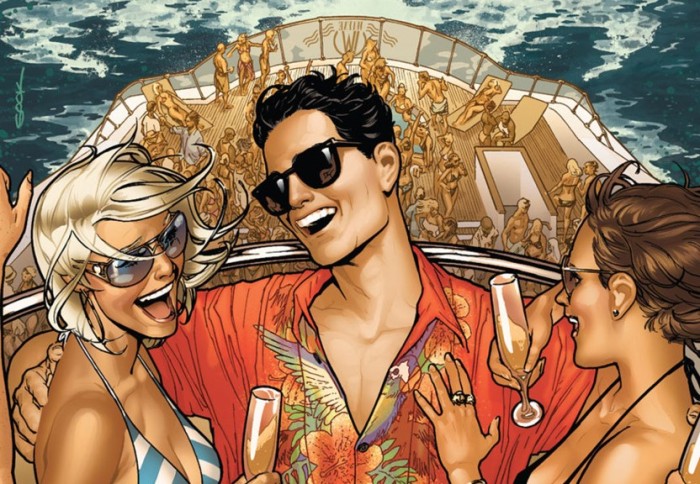
I’m finally catching up to the Man of Tomorrow. It’s a shadow I’ve stood since less than three years old, watching on my grandparents’ rabbit-eared television the first movie I’d ever seen in my life: Superman ’78 starring Christopher Reeve. It’s a film which makes a fairly explicit calculation which has stuck with me ever since. Clark leaves Smallville upon his earthly father’s demise at eighteen, immediately after which holes up in the Fortress of Solitude under the tutelage of his celestial father, placing his arrival in Metropolis and the beginning of his heroic career squarely at age thirty. I’d later learn all of this to be Christological references on the part of Richard Donner; the only childhood account of Jesus was at the age of twelve when he visited the temple at Jerusalem to “be about his Father’s business,” the next eighteen years of his life unrecorded till he begins his ministry at “about the age of thirty.”
Come this Saturday, like Superman in the film and Jesus in the gospels, I too will be thirty. And for the entirety of those three decades, my greatest hero, the most significant influencer on my morality and imagination both, has always been the character of Superman. One of the earliest photographs of myself as a toddler has me sporting the “S” insignia. I recall a palpable sense of excitement prior watching the Christopher Reeve movie, indicating that even at the tender age of two I’d absorbed through cultural osmosis an appreciation for the first and most superlative superhero. I later learned to read from pouring over John Byrne’s Man of Steel #5 every day in first grade, and falling asleep to the accompanying cassette tape ever night. By the time second grade came around, and the teacher asked each one of us what we wanted to be when we grew up, while all my classmates answered sports stars and veterinarians, I responded “Superman.” And to this day, when my alarm blares in the morning, it’s to the bombastic trumpets of John William’s iconic score, a reminder from the moment I wake up of the kind of man I ought to emulate throughout the day to come.
Having already failed in my brief career as a costumed crime fighter like Clark, I’m buying myself for my birthday the next best thing: a piece of commissioned art of myself by one of my favorite comic book artists in classic superhero style; if I can’t bring superheroes off the page and into the real world, I’ll simple have to don a fiction suit and meet them where they’re at.
But evidently Max Landis has seen fit to shower me with a surprise present; an issue as superb as American Alien #3 could be nothing else (and about a birthday party, no less! Though the one I’m throwing aims to be bigger yet). Barring the weak art in the second issue, the series as a whole so far is easily the best Superman story since All-Star. And like Morrison’s masterpiece, this issue plays with and improves upon Silver Age silliness. Two terrific tropes of that era are evident: 1) the close resemblance to the point of prince-and-pauper-esq interchangeability between Clark Kent and Bruce Wayne, and 2) Clark’s penchant for elaborate ruses as his preferred means of problem solving.
But despite pulling from the sixties, American Alien is an altogether modern take on the character. Modern not as in “dark and gritty,” to be clear. This is more Mark Waid’s Archie than Zack Snyder’s Man of Steel. Clark is a twenty-first century twentysomething here, even disproving the “Man of Steel, Woman of Kleenex” hypothesis with future Wonder Woman archnemesis Barbara Minerva. But such in no way imputes upon his moral fiber, which is brought into center-focus as the humble farmer’s son from the flyover states sees how the one percent parties. One particularly poignant moment has Clark meditating aloud on the cost of a bite of gold-flake crusted caviar relative to the surgical costs of a friend back home. Wisely, Landis balances the heavy moments with contrasting levity, such as a ridiculously one-sided confrontation between a seemingly drunk Clark and the assassin Deathstroke.
Joëlle Jones offers the series’ best pencils to date. Her style seems not too dissimilar to that of Hendry Prasetya from this week’s Mighty Morphin Power Ranger’s #0, albeit with thicker inks. One would never confuse their art, but both seem unique improvements on the slightly-flattened look popularized by Fiona Staples of Saga fame. Worthy of particular praise is the splash page montage of Clark embracing his “secret identity” as Bruce Wayne, becoming the life of the party, playing DJ and pouring cocktails like they were part of his power set.
The vignette format is working well for the series, so much so that it’s a wonder more writers don’t employ such. Comics seem particularly well suited for loosely connected one-offs, given the current distribution format of single-issue floppies released monthly as part of a series. Other anthology series have been similarly artistically successful, such as the digital-first Adventures of Superman and Neil Gaiman’s Miracleman; hopefully American Alien will be joined in the future by a move away from the current trend of serialized storytelling and strongly connected continuities.
What Landis did for the antihero in Chronicle he’s doing for the original superhero here in American Alien. Never once does he neglect the emotional core of the characters, all while navigating successfully between being reverently referential and refreshingly original. In my thirty years of following the character of Superman, rarely have I read a run or series so supremely spot-on and satisfying.
9.0/10



Pingback: Supergirl: Being Super | The Hub City Review